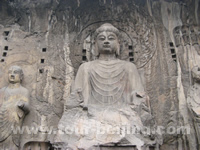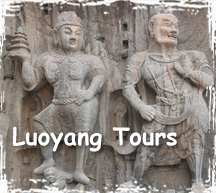Luoyang Longmen Grottoes

Luoyang Longmen Grottoes are located sixteen kilometers south of Luoyang in Henan Province, on the banks of the Yu River. The grottoes and niches of Longmen contain the largest and most impressive collection of Chinese at of the late Northern Wei and Tang Dynasties (316-907). These works, entirely devoted to the Buddhist religion, represent the high point of Chinese stone carving. These renowned artistic treasures are now protected as a National Key Cultural Relics Protected Unit and listed as a World Cultural Heritage Site in 2000. Longmen Grottoes in Luoyang, Mogao Grottoes in Dunhuang, as well as Yungang Grottoes in Datong are called “the Three Stone Carving Treasures in China”.
The grottoes were hewed and carved during the Northern Wei Dynasty, through the dynasties of East and West Wei, Northern Qi, Sui, Tang, and Northern Song. Altogether there are more than 2,100 grottoes at Longmen, with more than 100,000 statues, some 3,600 inscriptions and stelaes, and forty Buddha's stupas. The finest grottoes are the Northern Wei-period Guyang Grotto, the Binyang Grotto, the Lianhua Grotto, and the Tang-dynasty Qianxi Temple, among others. Some of the stelaes and inscriptions have become treasures among China's calligraphic arts, including the Tang-dynasty calligraphed work by Chu Suiliang (596-659).
 Fengxian Temple is the south of Longmen Mountain, established in BC 493. It is the largest grottoes in the open air, the representative works of Tang-Dynasty carving arts. The Buddhist is 36-meter wide from north to south, 41-meter deep from east to west and accompanied by eleven sculptures. The main Buddhist, Lushena, is 17.14-meter high, with plump face, slender eyebrow, her eyes radiating the wisdom. According to the inscription on the sculptures, Wu Zetian helped finance the construction with twenty?thousand 'guan' of money, and personally participated in leading ministers in the ceremony of 'opening the light,' i.e. opening the eyes of the Buddha. There is a large stone on the east bank of the Yi River, commonly called the beating-the-drum rock, which is said to be where Wu Zetian played music at the time of the ceremony.
Fengxian Temple is the south of Longmen Mountain, established in BC 493. It is the largest grottoes in the open air, the representative works of Tang-Dynasty carving arts. The Buddhist is 36-meter wide from north to south, 41-meter deep from east to west and accompanied by eleven sculptures. The main Buddhist, Lushena, is 17.14-meter high, with plump face, slender eyebrow, her eyes radiating the wisdom. According to the inscription on the sculptures, Wu Zetian helped finance the construction with twenty?thousand 'guan' of money, and personally participated in leading ministers in the ceremony of 'opening the light,' i.e. opening the eyes of the Buddha. There is a large stone on the east bank of the Yi River, commonly called the beating-the-drum rock, which is said to be where Wu Zetian played music at the time of the ceremony.The Guyang Carve is the earliest of its kinds and is abundant for its calligraphy, which are the curiosa for the disquisition of calligraphy history.
The main Sakyamuni in Binyang Carve is is standing and is 5.1 meters tall. The cave is carved with architectural details and floral designs, with scrolling grass patterns, lotus flowers, Baoxiang flowers and so on, all very finely carved. A large lotus flower is carved in high relief on the ceiling.
Questions & Answers:




